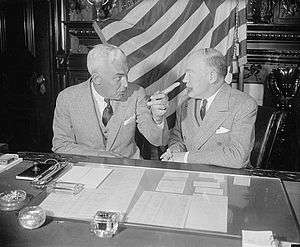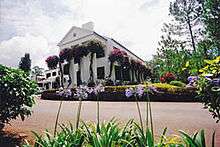High Commissioner to the Philippines

High Commissioner to the Philippines was the title of the personal representative of the President of the United States to the Commonwealth of the Philippines during the period 1935–1946. The office was created by the Tydings–McDuffie Act of 1934, which provided for a period of transition from direct American rule to the complete independence of the islands on July 4, 1946. It replaced the office of Governor-General of the Philippines, who had direct executive authority. Under the Commonwealth, executive power was held by an elected Filipino President. The role of the High Commissioner was largely ceremonial.
Only three individuals held the office of High Commissioner. They were:
- Frank Murphy, November 15, 1935 – December 31, 1936;
- Weldon Jones, December 31, 1936 – February 27, 1937 (Acting)[1]
- Paul V. McNutt, 1937–1939 and 1945–1946; and
- Francis Bowes Sayre, Sr., 1939–1942.
Murphy had previously served as Governor-General. Sayre's tenure was interrupted by the Japanese occupation of the Philippines during World War II. McNutt became the first United States Ambassador to the Philippines after Philippine independence in 1946.
High Commissioner's Residence
With the inauguration of the Philippine Commonwealth, Malacañan Palace was turned over to the President of the Philippines, necessitating a new home for the highest American government official in the Philippines. A new location was found along now-Roxas Boulevard and a High Commissioner's Residence was built. According to the book titled Manila Americans by Lewis Gleeck. "On April 1, 1937, McNutt arrived (in Manila) with Mrs. McNutt and a sixteen-year-old daughter. Since the relinquishment of Malacañang, there had been no official residence for the High Commissioner, so (Paul) McNutt moved into El Nido, the sumptuous Dewey Boulevard residence of Attorney E.A. Perkins...".[2]
On January 2, 1942, as Japanese forces entered the city of Manila, four members of the High Commissioner's staff, Elise Flahaven, George Gray, Virginia Hewlett and Margaret Pierce, lowered the American flag that flew at the High Commissioner's headquarters, burned it and buried its ashes to prevent its capture by the Japanese. On February 22, 1945, General Douglas MacArthur, Supreme Commander of the Allied Forces in the Southwest Pacific Area, again raised the flag at the High Commissioner's headquarters after recapturing Manila.
The High Commissioner's headquarters today houses the American embassy in the Philippines.
The American Residence

The American Residence in Baguio was built to be the summer home of the High Commissioner, to replace The Mansion that was the Governor-General's summer residence and that had been turned over to the president of the Philippines upon the inauguration of the Commonwealth.
See also
Notes
- ↑ Annual Report of the Chief of the Bureau of Insular Affairs
- ↑ The residence is shown in 1938 in a short film by Andre de la Varre titled Manila, Queen City of the Pacific. A video of the film was uploaded to YouTube on May 6, 2008 by travelfilmarchive.